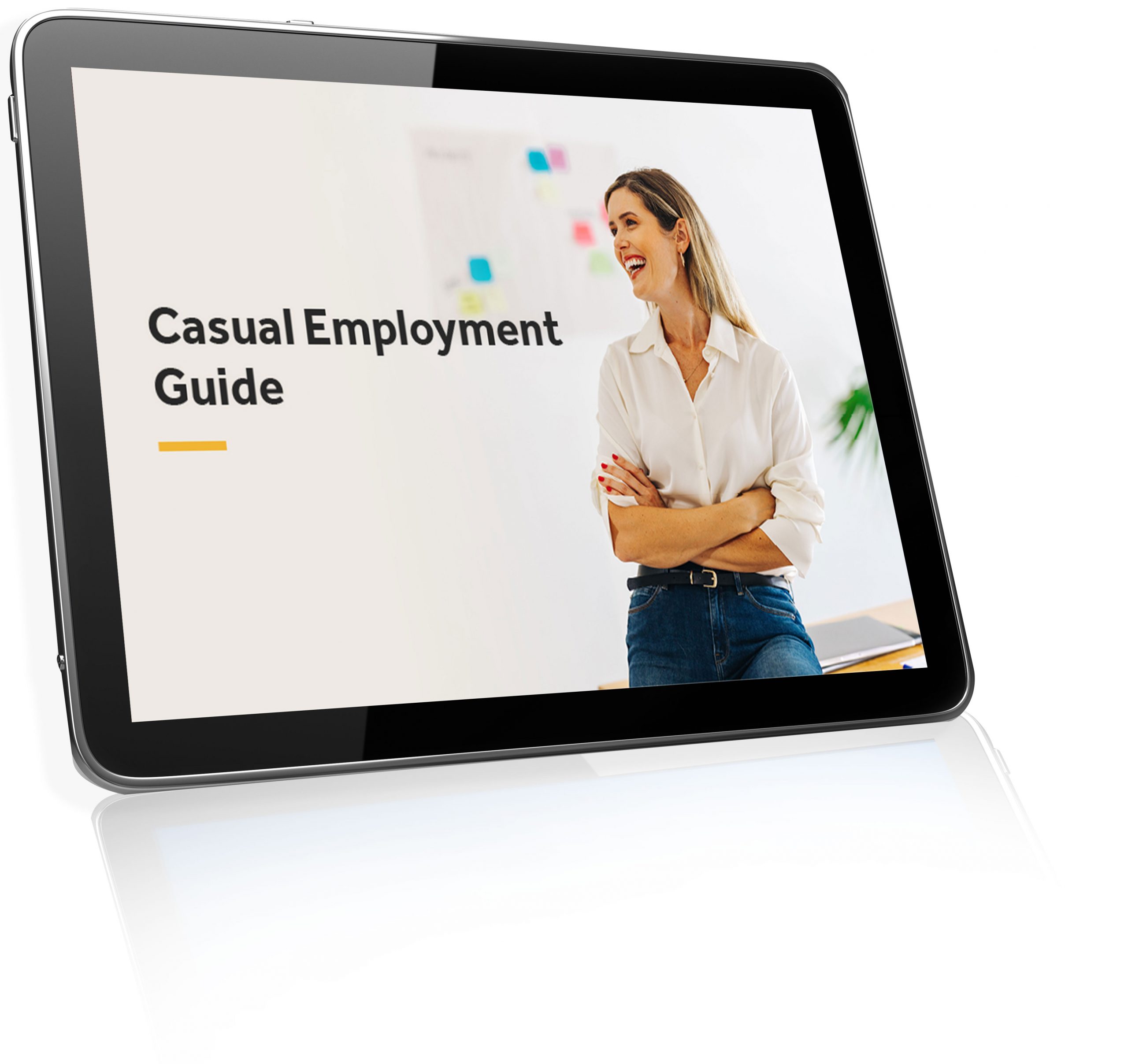
When it comes to hiring new staff, there are a number of employment arrangements to choose from. One of the biggest workforce dilemmas hiring managers face is deciding between casual vs permanent employees.
It’s important to weigh up your decisions carefully – the choices you make can have wide ranging implications in your business. This guide explains the key differences between permanent and casual staff, helping you make your next hire the perfect hire.
The key differences
The key difference between casual and permanent employment is that a permanent employee has an expectation of ongoing work.
When it comes to permanent employees, many modern awards require employment contracts to outline set days and hours, as well as specific start and finish times.
A casual is generally employed with no firm advance commitment to regular or ongoing work. Because casuals are only given shifts based on the needs of employer, their workdays and hours are often irregular,
What is a casual employee?
An employee is considered a casual if they accept a job offer without the employer giving any firm advance commitment to ongoing work or an agreed work pattern.
For example, if an employee is only given hours during busy periods, their roster changes each week, and they can refuse or swap shifts, they have likely been hired on a casual basis.
What is a permanent employee?
While casual employees are only given work on a basis of the employer’s needs, permanent employees are contracted to either full-time or part-time employment.
Permanent employees and their employers enter into a long-term, ongoing employment relationship, the terms of which are laid out in an employment agreement or contract.
A permanent employee’s work arrangement will likely involve the following:
Set hours of work each week (either full-time or part-time).
No specific employment end date.
A minimum notice period for redundancy or termination of employment.
Leave entitlements, such as annual leave, personal leave, and in some cases, long service leave.
Hours of work
The most important distinction between permanent and casual employees is the expectation of regular, ongoing and systematic working hours.
Permanent employees:
A permanent employee has a minimum amount of guaranteed hours each week. For full-time employees, this is usually 38 hours per week. Anything less than 38 hours per week is classified as part-time employment.
For example, a permanent full-time employee may work 9 am to 5 pm, Monday to Friday, or a total of approximately 38 hours per week over a rotating roster. Regardless of their work times, a permanent employee can expect regular and systematic hours on an ongoing basis.
Casual employees:
Casual employees are offered no firm advance commitment of guaranteed regular hours. This means the hours worked by casual employees are often more sporadic than those of permanent staff and may fluctuate from week to week, depending on the needs of the employer.
Employers should be aware that many modern awards contain minimum engagements for casual staff. This means that you must roster or pay a casual employee for a minimum number of hours on each occasion you use them. For more information, refer to the guidelines in the employee’s relevant modern award.
Work patterns
Another significant difference between casual and permanent employees is the pattern of their normal working hours.
Permanent employees:
Permanent employees tend to work set hours on the same days each week. This work pattern is normally agreed on in writing in the employment contract. There is an expectation that the employee will work the shifts allocated to them on an ongoing basis until they either resign or their employment is terminated.
Casual employees:
A casual employee’s weekly schedule involves irregular hours and will change based on the employer’s needs. This means there tends to be no discernable pattern to the days and hours they work.
A casual does not have to work the shifts offered to them by their employer. Instead, they have the right to either accept, refuse, or swap shifts as it suits them.
Employers should be mindful that giving casuals a regular or systematic pattern of work may allow them to access the same paid entitlements as permanent staff.
Additionally, terminating a casual who has had a regular or systematic pattern of work can lead to an unfair dismissal claim.
Wages and pay
When deciding whether to hire either permanent or casual employees, it’s always wise to consider the differences in wages and pay.
Permanent employees:
A full-time permanent employee’s pay is usually based on an annual salary, either outlined in a relevant modern award or their employment contract. A part-time permanent employee’s will also normally be based on an annual salary, but calculated pro-rata based on the number of hours they work.
Casual employees:
A casual employees pay is based on an hourly rate, with an additional amount included called ‘casual loading‘. Casual loading is extra money paid to casual workers over and above the normal hourly rate that permanent staff receive in the same job (normally calculated at an additional 20-25%).
Casual loading is often seen as compensation for the lack of paid entitlements and job security that come with a being a casual worker.

Are you considering hiring casuals?
It can be tricky for business owners to keep up with pay and leave entitlements for casual employees. Our FREE E-Guide covers all the basics of casual employment for small businesses, helping you build the flexible workforce needed to take your company to the next level.
Leave entitlements
As well as wages and pay, it’s crucial to factor in the different leave entitlements that permanent and casual employees receive. These entitlements make up an important part of the long-term cost that hiring a new staff member entails.
Annual leave
Permanent employees:
In line with National Employment Standards (NES), a full-time permanent employee is entitled to a minimum of 4 weeks of paid annual leave per year.
A part-time permanent employee is also entitled to a minimum of 4 weeks of paid annual leave per year, with the number of hours calculated pro-rata. For example, a part-time employee who normally works 25 hours a week would be be entitled to a minimum of 100 hours each year.
A permanent employee’s annual leave is accrued throughout the year based on the number of hours worked.
Casual employees:
Unlike permanent staff, casual employees do not receive any entitlements to paid annual leave. Because they have the right to refuse shifts, they are free to take time off work whenever they choose. However, this time away is unpaid and needs to be budgeted for by the casual.
Personal leave
Permanent employees:
In line with the Fair Work Act and NES, full-time employees should receive 10 days of paid personal leave per year (also known as sick or carer’s leave). The amount of paid personal leave part-time employees receive is calculated pro-rata (1/26 of an employee’s ordinary hours of work in a year).
A modern award, registered agreement or employment contract may offer more paid personal leave, but it should never be less than the amount specified by NES.
Much like annual leave, a permanent employee’s personal leave accrues throughout the year.
Casual employees:
Unlike permanent staff, casuals are not entitled to paid personal leave. If they’re unable to work due to illness or another personal issue, they simply don’t get paid.
Paid family and domestic violence leave
All employees can access 10 days of paid family and domestic violence leave each year. This includes permanent and casual employees.
Paid family and domestic violence leave also comes from the minimum entitlements of the NES. A new employee’s paid leave entitlement is available in full immediately and renews on their work anniversary. However, if this leave is unused it doesn’t accumulate from year to year.
Compassionate leave
All employees, including permanent and casual staff, are entitled to compassionate leave when a member of their immediate family dies or suffers a life-threatening illness or injury.
Permanent employees are entitled to 2 days of paid compassionate leave per occasion, while casuals receive 2 days of unpaid compassionate leave per occasion.
This leave can be taken as a single 2-day period, 2 separate days, or over any time period that the employer and employee agree on.
Termination and redundancy
Employers must have a valid reason for dismissing or terminating a permanent employee, such as poor performance or gross misconduct. The employer is required to give a written notice of termination and meet the notice period laid out in the employment contract or agreement.
When a permanent employee’s job is made redundant, the employer may need to give them redundancy pay (also known as severance pay). Under the National Employment Standards, redundancy pay doesn’t need to be paid in some circumstances, such as if the employer is a small business.
On the other hand, a casual employment arrangement can be ended at any time without notice of termination. If a casual’s job becomes redundant, employers are not obligated to give them any redundancy pay.
Is permanent or casual employment better?
Whether permanent or casual employees are a better fit for your company will depend on your staffing needs and the unique characteristics of your business.
Because casual staff do not have to accept shifts, most employers will build a team of permanent staff to meet their baseline requirements. This can then be supplemented with casuals who act as a safety valve during busy periods.
Hybrid workforce models made up of a mix of full-time, part-time and casual employees will often give the perfect balance of stability and flexibility.
Frequently Asked Questions
What is a regular and systematic pattern of work?
Working on a regular and systematic basis doesn’t require the employee to work every week or even on the same days. There only needs to be some sort of discernible regular pattern in a casual employee’s work hours.
Employers have been caught out before because they’ve failed to understand that regular doesn’t necessarily mean “frequent”.
For instance, a casual employee who is only rostered on the last Friday of every month works infrequently, but still has a regular and systematic work pattern.
What is casual conversion?
A casual employee can switch to full-time or part-time permanent employment at any time, providing both the employer and employee agree to it. This is known as ‘casual conversion’.
Under the Nation Employment Standards, casual employees who work a regular and systematic pattern for 12 months or more have the right to access a ‘casual conversion’ pathway and become a permanent employee. At this stage, they are also entitled to request flexible working arrangements.
Small businesses (with fewer than 15 employees) do not have to offer their staff casual conversion.
How much is casual loading?
Casual loading is normally calculated as an additional 20-25% of the ordinary rate of pay. For example, casual employees covered by the General Retail Industry Award are entitled to an extra 25% of the standard hourly rate for permanent employees in the same business and role.
In some cases, a different amount of casual loading will be laid out in an employment contract or agreement. However, it cannot be less than the amount specified in the employee’s applicable modern award.
If you’re an Australian business owner with queries about contracts, pay and leave entitlements for casual or permanent employees, call Employsure’s FREE Advice Line on 1300 651 415 to get all your questions answered.



